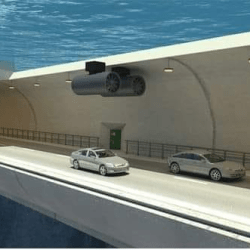The Gotthard Base Tunnel (GBT), stretching an astounding 57 kilometers (about 35 miles), is the longest and deepest traffic tunnel in the world. Completed in 2016, it is a testament to modern engineering, cutting through the Swiss Alps to connect Switzerland with Italy. This monumental infrastructure project revolutionizes transportation across Europe, offering unparalleled efficiency and environmental benefits.
Key Features of the Gotthard Base Tunnel
1. Unparalleled Length and Depth
- Length: At 57 kilometers, the GBT surpasses all other traffic tunnels, securing its place as the world’s longest.
- Depth: The tunnel reaches a remarkable depth of 2,300 meters (7,500 feet) beneath the Alpine peaks, making it the deepest traffic tunnel globally.
2. Strategic Location
- The GBT runs beneath the Swiss Alps, a region historically known for its challenging topography that impedes overland travel.
- It links Erstfeld in the north to Bodio in the south, facilitating faster and more direct connections between northern and southern Europe.
3. State-of-the-Art Design and Construction
- Construction involved drilling through 28 million tons of rock over 17 years.
- It consists of two single-track tunnels, enabling seamless, bi-directional train travel.
- Advanced safety systems, including 178 cross-passages between the tunnels, ensure efficient evacuation in emergencies.
Importance of the Gotthard Base Tunnel
1. Enhanced Transportation Efficiency
- Reduced Travel Times: The tunnel significantly shortens travel times. For instance, journeys between Zurich and Milan have been reduced by about an hour.
- Freight Traffic: It can accommodate high-capacity freight trains, diverting heavy cargo from congested roads to rail, easing overland transportation bottlenecks.
2. Boost to European Connectivity
As part of the Trans-European Transport Network (TEN-T), the GBT enhances cross-border trade and travel, linking major economic hubs across the continent.
3. Environmental Impact
- By shifting freight and passenger traffic from road to rail, the tunnel reduces carbon emissions, aligning with Europe’s sustainability goals.
- It helps protect the fragile Alpine environment from heavy vehicle traffic.
Construction: A Feat of Modern Engineering
1. The 17-Year Project Timeline
- Groundbreaking Ceremony: Construction began in 1999.
- Completion and Opening: The GBT opened to commercial traffic on June 1, 2016.
2. Challenges Encountered
- Navigating through varying geological formations required innovative tunneling techniques.
- Extreme depth presented challenges in ventilation, safety systems, and structural integrity.
3. Workforce and Machinery
- Over 2,600 workers were employed at peak construction.
- Specialized machinery, including massive tunnel boring machines (TBMs), carved through the Alpine rock.
Economic and Social Benefits
1. Trade and Tourism
The tunnel supports smoother trade routes and enhances tourism by providing quicker and more reliable access between regions.
2. Regional Development
Regions along the tunnel route have experienced economic growth, as improved connectivity stimulates business and investment.
3. Passenger Comfort
Travelers benefit from reduced travel times, enhanced punctuality, and a comfortable alternative to road travel.
The Gotthard Base Tunnel in Numbers
| Feature | Details |
|---|---|
| Length | 57 kilometers (35 miles) |
| Depth | 2,300 meters (7,500 feet) |
| Construction Duration | 17 years |
| Cost | Approx. €12 billion |
| Speed Capacity | Trains travel up to 250 km/h (155 mph) |
| Daily Capacity | 260 freight trains, 65 passenger trains |
Legacy of the Gotthard Base Tunnel
The GBT symbolizes human ingenuity and determination. It addresses contemporary transportation challenges while respecting environmental constraints. As a critical piece of infrastructure, it is a proud achievement for Switzerland and a vital artery in Europe’s transportation network.

FAQs About the Gotthard Base Tunnel
- Why is the Gotthard Base Tunnel significant?
It is the longest and deepest traffic tunnel in the world, dramatically improving transportation efficiency between northern and southern Europe. - How long did it take to build the tunnel?
Construction spanned 17 years, from 1999 to 2016. - What is the depth of the Gotthard Base Tunnel?
The tunnel reaches a depth of 2,300 meters (7,500 feet) below the Alpine peaks. - How does the tunnel benefit the environment?
By shifting freight and passenger traffic from road to rail, the GBT reduces carbon emissions and protects the Alpine ecosystem. - What challenges were faced during construction?
Engineers had to overcome varying geological conditions, extreme depths, and logistical complexities during the 17-year project. - What is the maximum speed of trains in the tunnel?
Trains can travel at speeds of up to 250 km/h (155 mph) through the tunnel.

















